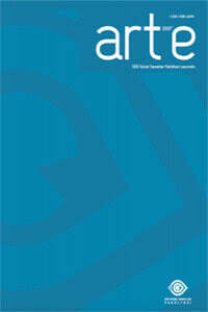"Yetişkinler İçin Hayalet Öyküleri", Aby Warburg ve Pathosformel Sanat Tarihi
Öz Bu çalışma Warburg’un Pathosformel olarak adlandırdığı yöntemin teorik bağlamda nasıl karakterize edildiğini ve bir sanat tarihi yöntembilimi olarak nasıl kullanıldığını analiz edecektir. Çalışmanın ilk bölümü Aby Warburg’un yaşantısı ve Pathosformel yaklaşımın ortaya çıkışını tarihi bir izlekte ortaya koymaya çalışacaktır. İkinci bölümde ise yaklaşımın bellek kuramları ile olan ilişkisi Mnemosyne (bellek) Atlası üzerinden incelenerek bir sanat tarihi kuramı olarak kültürel analiz ve imgelerin kültürlerarası örtük bağları üzerinde durulacaktır. Anahtar kelimeler: Pathosformel, bellek, Rönesans, ikonoloji, metodoloji
Anahtar Kelimeler:
Pathosformel, Metodoloji, İkonoloji, Bellek, Rönesans
___
Agamben, G.,(2013) Nymphs, trsl: Amanda Minervini, Seagulls Books: UtahAgamben, G., (1994), “Aby Warburg and the Nameless Science”, Potentialities, trsl: Daniel Heller Roasen, Stanford University Press: Standford 89-166
Akay, A.,(2006) Sanat Tarihi Sıradışı Bir Disiplin, Yapı Kredi Yayınları: İstanbul
Buchloh, B.,(1999) “Gerhard Richter's "Atlas": The Anomic Archive” , October, Vol. 88 (Spring),The MIT Press, pp. 117-145
Campbell, J.,(1991). The Power of Myth (with Bill Moyers). Anchor Books edition (non-illustrated smaller-format edition). s. 111.
Cassirer, E.,(1925), Dedication letter to Aby Warburg, in Idem, The Individual and the Cosmos in Renaissance Philosophy transl. by M. Domandi, Oxford, Blackwell, 1963
DeMallie, R,J. ed. (1985). The Sixth Grandfather: Black Elk's Teachings Given to John G. Neihardt, University of Nebraska Press. s. 47.
Durantaye, L.L., (2008) “Ghost Stories for the Very Adult” The Believer, January, Volume 6, Number 1. 26-30Fernie, E. (1995) Art History and Its Methods: A Critical Anthology, Phaidon, London
Ginzburg, C., (2007) Efsaneler Amblemler İzler, Morfoloji ve Tarih, çev: Mehmet Moralı, Kırmızı Yayınları:İstanbul
Gombrich,E. H.,(1999) “Aby Warburg: His Aims and Methods: An Anniversary Lecture”
Journal of the Warburg and Courtauld Institutes, Vol. 62. pp. 268-282.
Hodapp, Christopher L.,(2010) Deciphering the Lost Symbol: Freemasons, Myths and the Mysteries of Washington, D.C. Ulysses Press: Berkeley.
Iversen, M., Melville, S., (2010) Writing Art History, Disciplinary Departures, Universtiy of Chicago Press: Chicago.
Johnson, C., (2012) Memory, Metaphor, and Aby Warburg’s Atlas of Images, Cornell University Press: New York.
Kaek, M.,(2016), “Of Marble Women and Sleeping Nymphs”, Translating Myth, ed: Ben Pestell, Pietra Palozzolo, Leon Burnet, Routledge: New York. s.131-144
Manguel, A.,(2008) Geceleyin Kütüphane, çev: Dilek Şendil, Yapı Kredi Yayınları: İstanbul
Markman, P., Markman, R., (1989) Mask of the Spirit: Image and the Metaphor in Mesoamerica, University of California Press: Berkeley
Mooney, J.,(1896) The Ghost Dance Religion and Wounded Knee, Dover Publications: New York
Papapetrosi S.,(2010), “World Ornament”, Anthropology and Aesthetics, Res 57/58 Spring Autumn, s. 309-330
Preziosi, D., der.(1998) The Art of Art History: A Crritical Anthology, Oxford University Press, Oxford, New York
Rampley, M.,(2001), “Mimesis and Alegory: On Aby Warburg and Walter Benjamin”,Art History as Cultural History, ed. Richard Woodfield, Overseas Publ: Amsterdam, s. 121-151.
Russel, Mark, A., (2007) Between Tradition and Modernity, Berghahn Books: New York
Steinberg, P.M., (1995) “Aby Warburg’s Kreuzlingen Lecture: A Reading”, Images From The Region of the Pueblo Indians of North America, Aby M Warburg, Cornell University Press:Ithaka pp: 59-110
Warburg, A., (2001) “The Entry of the Idealizing Classical Style in the Painting Of Early Renaissance”, Art History as Cultural History, ed. Richard Woodfield, Overseas Publ: Amsterdam. pp.7-33
Warburg, A.,(1999) “Dürer and Italian Antiquity, 1905”, The Renewal of Pagan Antiquity: Contributions to the Cultural History of the European Renaissance, Translation by David Britt Getty Center for the History of Art and the Humanities: Los Angeles, pp.555-558
Warburg, A., (1999) “Pagan-Antique Prophecy in Words and Images in the Age of Luther,1920”, The Renewal of Pagan Antiquity: Contributions to the Cultural History of the European Renaissance, Translation by David Britt Getty Center for the History of Art and the Humanities: Los Angeles, pp.597-667
Wind, E., (2009), “Warburg’s Concept of Kulturwissenschaft and its Meaning for Aesthetics”, The Art of Art History, Ed. D. Preziosi, New York: Oxford University Press, s. 189-194.
Wolf, G.,(2016), “Warburg’s Boticelli and Boticelli’s Nymph”, Boticelli Re-Imagined, ed. Mark Evans, Stefan Weppelmann, Victoria Alberts Publishing: Londra, s.102-106.
Zilberg, J., (2011) “A Note On Warburg”, Transtechnology Research, Plymouth University
- Yayın Aralığı: Yılda 2 Sayı
- Başlangıç: 2008
- Yayıncı: Süleyman Demirel Üniversitesi Güzel Sanatlar Fakültesi
Sayıdaki Diğer Makaleler
"YETİŞKİNLER İÇİN HAYALET ÖYKÜLERİ" ABY WARBURG VE PATHOSFORMEL SANAT TARİHİ
KÜLTÜREL BİR OLGU OLARAK NAKIŞ VE TÜRK RESİM SANATINDAKİ YANSIMALARI
Tekstil Yüzey Tasarımında Yüzyıllık Etki: Lucienne Day
Füreya Koral: Meclis Seramikleri
Duyuların Mekânsal Deneyimleri Şekillendirmesi: Sagrada Familia Kilisesi
Yasemin Erkan Yazıcı, Neşe Çakıcı Alp
Geleneksel Çömlekçilikte Değişim ve Yüksek Pişirim Cazibesi
